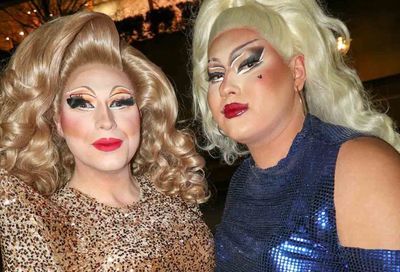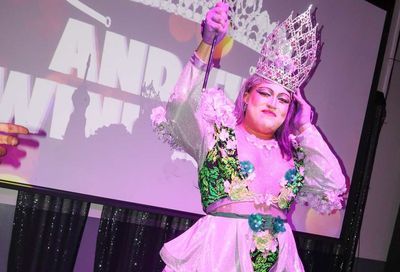Crossed Tracks
Commentary: In Exile
While recently speaking to someone who lives in D.C., I was told that Columbia Heights, the neighborhood in which I lived for many years, is no longer considered ”ghetto.”
I lived in two places in Columbia Heights. The first was by the corner of Irving and Sherman. This was sometime around 2001 and the neighborhood did indeed have a dicey flavor to it. I lived with a nice lady who agreed not to care that I was gay if I didn’t care that she was pagan. The guys on my block, who would always greet me loudly as I passed, referred to me as Slim.
Until last week, that was the last time I had lived in a neighborhood that was considered ghetto. I remember my aunt in 2001, with unveiled concern that her nephew was the sole white kid living on his block, asking me if where I lived was a black neighborhood or a mixed neighborhood. ”It’s mixed,” I said, ”black and Hispanic,” feeling savvy and urban. After that, I moved again in Columbia Heights, to a group house much farther west, off of 16th Street, and then to an Italian neighborhood in Brooklyn, and then to the East Village of Manhattan, also ”mixed” (a mix of hipsters and crazy people).
As of last week, I’m back in the borough of Brooklyn, in a neighborhood not yet turned inside out by gentrification. I ended up here through a series of events — unfortunate events — back in a place considered ”ghetto.”
There are drawbacks to this neighborhood. For one thing, there are very few places to eat. The subway out here runs on an elevated track, which is loud, and the train cars are old and far crappier than the snazzy new automated cars on the Manhattan lines. Because we’re located across the street from a housing project, with which we share a water main , our water pressure sucks. And the one place to buy produce is a place you wouldn’t want to — a vast supermarket called ”Food Dimensions,” the sign written in that 1980s, War Games-ian computer font, with a selection of tangerines that look like they’ve been dropped from an airplane. Much of the milk is minutes from expiration.
It was depressing to move here, especially after getting used to the hubbub of downtown Manhattan, where a fun, absurdist crisis that appeared to demand everyone’s participation always seemed to be unfolding: the power on the block has gone out and so people have built a bonfire in the park and now everyone’s sitting around it drinking wine; a heavy rain has flooded the subway station and so men in suits are carrying women in spiked heels over the water as if they were honeymoon brides; a thousand anti-car protestors on bikes have clogged the streets and now everyone is running up to their apartments to grab their own bikes and ride along with them; a restaurant kitchen has caught fire and so suddenly the stoops are filled with diners holding bowls of gazpacho.
Crises in my new neighborhood don’t seem nearly as playful. More often, they involve a fistfight or, once, a shooting. When the power goes out here, it can be days before it’s restored, and there’s no bonfire in the park. In fact, there’s no park.
Manhattan has done a one-eighty in the past 20 years. The early 1980s saw the East Village crumbling into the street, with a brisk heroin trade and ample crime retarding any chance of social uptick. Now it’s hard to even find a bad neighborhood in that borough. ”Ghetto” neighborhoods like Harlem are pawning off townhouses for $2 million a pop. The Lower East Side, once a junky’s paradise, now harbors a vintage furniture street market.
With everyone always tittering proudly about how safe New York has become, I almost forgot that there was any such thing as a crisis here that you might not want to be a part of. Most of the time, my new neighborhood is fine. It hums along with Caribbean music blaring from auto body shops and a large live-poultry warehouse that literally spews feathers onto the sidewalk from its air conditioning duct. But the absence of police presence, the abandoned buildings, the lack of produce or milk — it’s a different kind of chaos than what I’d gotten used to. The effect of a gentrified Manhattan has been that Manhattanites can more easily than ever forget that the idea of chaos-as-fun is a luxury, and that parts of the city aren’t hoping for a ”fun” kitchen fire.
There’s something about living in a gentrified neighborhood for a time. After a while, you get so addicted to comfort that anything vaguely different than comfort feels not so vague at all. You don’t really want to move in with the pagan lady and tolerate her weirdness, or live in the neighborhood where the train cars are old and loud. You don’t want a crisis that’s not organized and fun and absurd, and you kind of want to just pretend that the ghetto isn’t really there.
I haven’t been back to D.C. in nearly a year. I remember when I left, Columbia Heights had big plans for a shopping mall and theater complex called the Tivoli in a big, abandoned building. I have no idea if that project is in the works or not, or if it is, what it’s done for the area. Hopefully it’s serving as an anchor for the neighborhood, making things better for the locals — and the pagans.
Support Metro Weekly’s Journalism
These are challenging times for news organizations. And yet it’s crucial we stay active and provide vital resources and information to both our local readers and the world. So won’t you please take a moment and consider supporting Metro Weekly with a membership? For as little as $5 a month, you can help ensure Metro Weekly magazine and MetroWeekly.com remain free, viable resources as we provide the best, most diverse, culturally-resonant LGBTQ coverage in both the D.C. region and around the world. Memberships come with exclusive perks and discounts, your own personal digital delivery of each week’s magazine (and an archive), access to our Member's Lounge when it launches this fall, and exclusive members-only items like Metro Weekly Membership Mugs and Tote Bags! Check out all our membership levels here and please join us today!





















